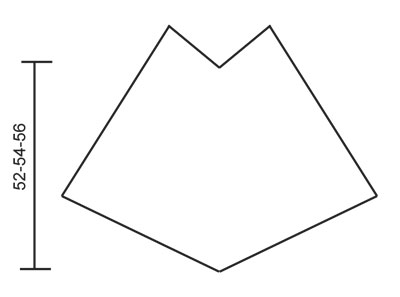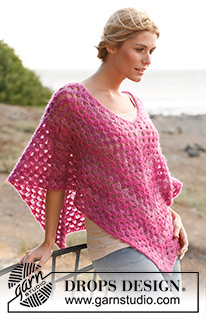Comments / Questions (47)
![]() Alice Sharpe wrote:
Alice Sharpe wrote:
Can I buy this pattern showing the different sizes?
03.10.2024 - 15:11DROPS Design answered:
Dear Mrs Sharpe, find the free crochet pattern in US-English here; then use the button "printer" to print the pattern. Happy crocheting!
03.10.2024 - 16:23
![]() MammaO wrote:
MammaO wrote:
If I want to make the neck are smaller,, how many chains do I start with?
06.05.2022 - 00:31DROPS Design answered:
Dear MammaO, we are unfortunately not able to adjust every pattern to every single requet, for any further assistance, please contact the store where you bought the yarn or any crochet forum. Thanks for your comprehension. Happy crocheting!
06.05.2022 - 07:48
![]() Shana Gomez wrote:
Shana Gomez wrote:
I am making the 137-25 poncho. My pints in both sides are not going straight down but vering to the side. I’m not sure what I have done wrong
17.02.2022 - 04:16DROPS Design answered:
Dear Mrs Gomez, it's a bit difficult to find the solution without seing your work - make sure the increases at both tips are always make upwards in the middle ch-space on mid back and mid front (insert a marker there can help). Bring your work to your store, or show them a picture per mail, so that they can help you - even per mail or telephone. Happy crocheting!
17.02.2022 - 10:31
![]() Meera Kapur Biswas wrote:
Meera Kapur Biswas wrote:
How can I make a border at the neckline and add tassels to the bottom in this design
02.12.2021 - 12:09DROPS Design answered:
Dear Meera, for the neckline you work 1 treble crochet in each stitch, around the whole neck. If you work more than 1 row, you need to decrease in mid front and mid back. As for the tassels, here you have a video about how to add them: https://www.garnstudio.com/lesson.php?id=17&cid=19 Happy crochetting!
05.12.2021 - 22:45
![]() Lois Sen wrote:
Lois Sen wrote:
I like this poncho. Can you show a video how to do the biggest size?
28.02.2021 - 04:17DROPS Design answered:
Dear Lois Seb, Unfortunatel we do not have a video showing the full making of this pattern, however, you can find our videor relevant to this piece below the pattern. Happy Crafting.
28.02.2021 - 20:23
![]() Judy wrote:
Judy wrote:
I'm new to this pattern. If you do 170, has anyone figured out how many " chains" ( 3 dc) you have before you have to do the increase? I want to do the biggest size, but do not understand when to do the increases? I'm not wanting to start only to have to rip it out because the increases are in the wrong space? Or is this post too late to get a response? Thank you
22.02.2021 - 02:09DROPS Design answered:
Dear Judy, you cast on 170 chains and on first row you have 102 dc, ie 34 dc groups, on first round; this means on 2nd round, you will have 32 dc groups between each increase + 2 dc-groups on mid front + 2 dc-groups on mid back = 36 dc-groups. Happy crocheting!
22.02.2021 - 09:42
![]() Marie wrote:
Marie wrote:
Bonjour, j'ai choisi ce modèle puisque le Beach Paradise à 2 fils est plus difficile. Est-ce possible que le Raspberry a été modifier dernièrement? C'est possible d'ajouter des franges au poncho?, merci.
15.09.2020 - 20:25DROPS Design answered:
Bonjour Marie, à priori ce modèle n'a pas été modifié ni corrigé récemment - qu'est ce qui pourrait vous y faire penser? Nous pourrions vérifier si vous constatez quelque chose. Vous pouvez tout à fait ajouter des franges, pensez juste à augmenter la quantité nécessaire - votre magasin DROPS saura vous conseiller si besoin - même par mail ou téléphone. Bon crochet!
16.09.2020 - 08:40
![]() Harmony Kieding wrote:
Harmony Kieding wrote:
OK, I am going to try an experiment, here- (probably another grand disaster in the making, hehe)- I am going to try doing the initial chain and Round 1 flat (not in the round)- and THEN try joining them AFTER Round 1 and from that point doing it in the round. Um, Erm, wish me luck !!!! (nervous laughter)
29.01.2020 - 09:57
![]() Harmony Kieding wrote:
Harmony Kieding wrote:
My beginning chain got twisted (without my knowing it, of course)- so I carefully counted every stitch, (170 carefully crocheted groups of 3 DC, chain 1 (skip two)... only to find out I had to rip the whole thing out. I wish there was some way of doing this whole project without having to use a beginning chain like that. *sigh*
28.01.2020 - 21:15DROPS Design answered:
Dear Mrs Kieding, this video below could help you. Happy crocheting!
29.01.2020 - 08:58
![]() Shannyn wrote:
Shannyn wrote:
Is there any way you could make a video for the xxl/xxxl size? This would be easier for me as a beginner and I also learn visually, not so much with written instructions. I want to make this poncho for my sister's birthday coming up soon.
02.08.2019 - 04:06DROPS Design answered:
Dear Shannyn, we have added your request to our todolist, to help you to show how to start the poncho. In the meantime, just cast on the requested number of chains, work first row as explained (you should get something like this, but in the round and not in rows) then from 2nd round you will increase for mid front and mid back as shown a href="https://www.garnstudio.com/video.php?id=635&lang=en">in this square, ie only increase on 2 places as explained in the pattern and not on 4 as shown in the square. Happy crocheting!
07.08.2019 - 10:34
Raspberry Smoothie#raspberrysmoothieponcho |
|
 |
 |
Crochet DROPS poncho in "Verdi". Size S- XXXL
DROPS 137-25 |
|
|
PONCHO: The piece is worked in the round from neck and down. Ch 130-150-170 on hook size 6 mm / J/10 and form a ring with 1 sl st in first ch. ROUND 1: ch 3, 1 dc in each of the next ch 2, * ch 1, skip 2 ch, 1 dc in each of the next 3 ch *, repeat from *-* until 2 ch remain, ch 1, skip ch 2, finish with 1 sl st in 3rd ch from beg of round and work 1 sl st in each of the first 2 dc from beg of round = 78-90-102 dc / 26-30-34 dc-groups. ROUND 2: 3 ch (= 1 dc), 2 dc in first ch space, ch 1, * 3 dc and 1 ch in next ch space *, repeat from *-* a total of 5-6-7 times, 3 dc in next ch space, ch 1, 3 dc in same ch space (= inc mid front), ch 1, * 3 dc and 1 ch in next ch space *, repeat from *-* a total of 12-14-16 times, 3 dc in next ch space, ch 1, 3 dc in same ch space(= inc mid back), 1 ch * 3 dc and 1 ch in next ch space *, repeat from *-* a total of 6-7-8 times, and finish with 1 sl st in 3rd ch from beg of round and work 1 sl st in each of the first 2 dc from beg of round = 28-32-36 dc-groups. From ROUND 3 until finished measurements: Continue to work as explained above, AT THE SAME TIME work 3 dc + ch 1 + 3 dc in ch space mid front and mid back (i.e. there will be 1 more dc-group between every tip on every round = 2 dc-groups more per round). Continue until piece measures approx. 52-54-56 cm / 20½"-21¼"-22" from neck and down mid front. Fasten off. CROCHET EDGE: At the top around the neck work an edge as follows on hook size 6 mm /J/10: 1 sc in first ch space, * ch 3, skip 3 dc, 1 sc in next ch space *, repeat from *-* and finish with 1 sl st in first sc. Fasten off. |
|

|
|
Have you finished this pattern?Tag your pictures with #dropspattern #raspberrysmoothieponcho or submit them to the #dropsfan gallery. Do you need help with this pattern?You'll find 5 tutorial videos, a Comments/Questions area and more by visiting the pattern on garnstudio.com. © 1982-2025 DROPS Design A/S. We reserve all rights. This document, including all its sub-sections, has copyrights. Read more about what you can do with our patterns at the bottom of each pattern on our site. |
|





































Post a comment to pattern DROPS 137-25
We would love to hear what you have to say about this pattern!
If you want to leave a question, please make sure you select the correct category in the form below, to speed up the answering process. Required fields are marked *.